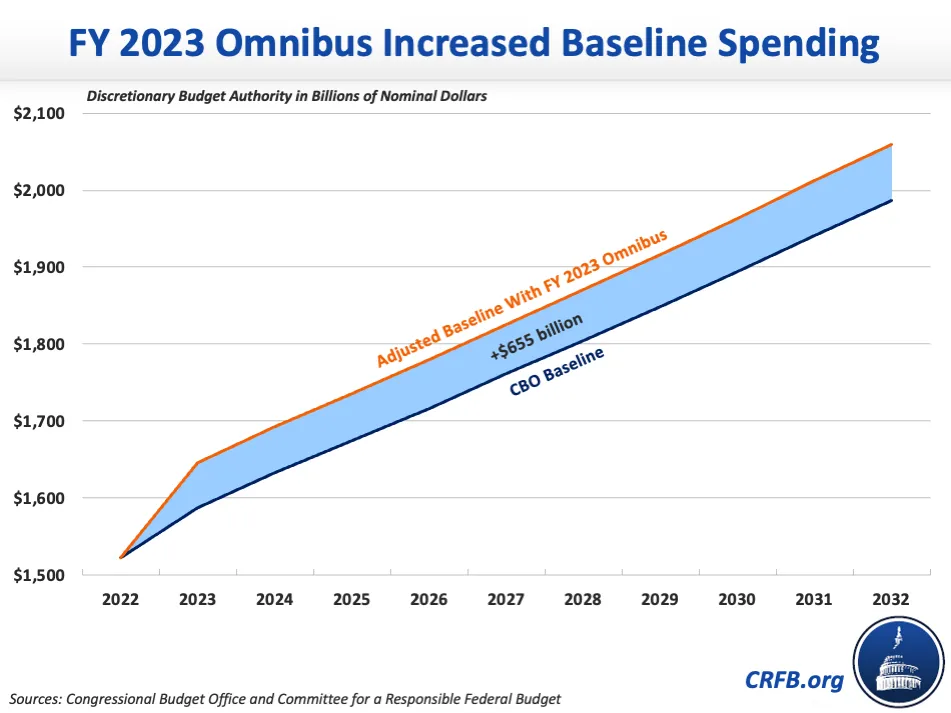FY 2023 Omnibus Means Over $700 Billion Boost to Baseline Spending
The recently-passed Fiscal Year (FY) 2023 omnibus appropriations package will substantially boost appropriations levels this fiscal year and into the future. We estimate this year's 9 percent increase will put total base appropriations 37 percent above the FY 2017 level and will increase baseline discretionary budget authority by $655 billion over the next decade, or by $740 billion when including one-time emergency funding for Ukraine and disaster relief. That's enough to increase debt by roughly 2 percent of Gross Domestic Product (GDP) by the end of the next ten years.
The FY 2023 omnibus appropriated $1.646 trillion of non-emergency budget authority for FY 2023. This represents a 9 percent ($134 billion) increase over the FY 2022 level of $1.512 trillion, including 10 percent on the defense side and 8 percent on the nondefense side. After subtracting $15 billion of phony changes in mandatory programs (CHIMPs) and $28.5 billion of special adjustments, the bill included $1.602 trillion of discretionary budget authority.
Not only did this fiscal year's appropriations grow faster than inflation or economic growth, but they represent the second-largest percent increase in at least a decade. They also come on top of several other large funding increases, including a 7 percent boost between FY 2021 and 2022 and a 10 percent increase between FY 2017 and 2018. (These figures include funding for Overseas Contingency Operations, or OCO, which since the conclusion of the statutory caps on discretionary spending at the end of FY 2021 have has been included in the base discretionary budget.)
These increases are cumulative, and as a result, FY 2023 discretionary spending is 37 percent higher than in FY 2017 – including 31 percent higher on the defense side and 43 more percent on the nondefense side. By comparison, price levels (as measured by the Chained Consumer Price Index) have grown by 19 percent over that period and total economic output has grown by 32 percent.

Because the omnibus bill increased spending faster than the rate of inflation, it also increased FY 2023 budget authority by nearly $60 billion relative to CBO's most recent baseline projection. Assuming appropriations grow with inflation going forward, as under standard budget practices, discretionary budget authority will be $655 billion higher over the next decade. This translates into a projected $30 billion increase in discretionary budget outlays in FY 2023 and $570 billion through 2032 relative to CBO's baseline (higher inflation than CBO's most recent projections would have already included some of this increase).

Including the over $85 billion of emergency budget authority to provide military, humanitarian, and economic assistance to Ukraine and to respond to hurricanes and other natural disasters, the FY 2023 omnibus bill will increase total discretionary budget authority by $133 billion in FY 2023 and by $740 billion over a decade relative to CBO's most recent baseline projection. That will translate into a roughly $750 billion increase in total discretionary budget outlays over a decade, including interest. It is likely to boost debt by about 2 percent of GDP by 2032.
The FY 2023 omnibus's 9 percent spending increase went above and beyond making adjustments to keep pace with today's high inflation. Given the challenges we face today with inflation at a 40-year high and the national debt on track to exceed record levels in the near future, lawmakers should have instead set reasonable spending levels consistent with their willingness to either offset the cost of added spending or pare back discretionary spending. Going forward, they should restore discretionary spending caps and work to contain the growth of discretionary spending while also lowering health care costs, boosting revenue, and enacting additional deficit reduction.


